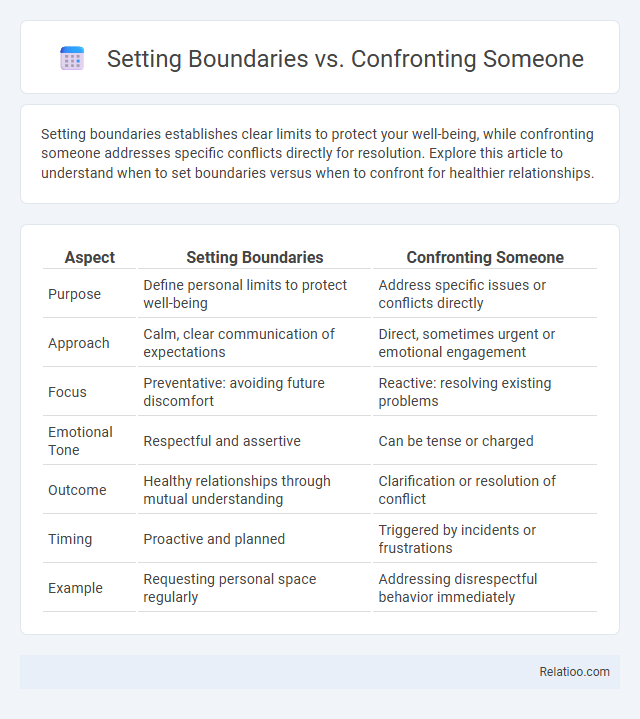Setting boundaries establishes clear limits to protect your well-being, while confronting someone addresses specific conflicts directly for resolution. Explore this article to understand when to set boundaries versus when to confront for healthier relationships.
Table of Comparison
| Aspect | Setting Boundaries | Confronting Someone |
|---|---|---|
| Purpose | Define personal limits to protect well-being | Address specific issues or conflicts directly |
| Approach | Calm, clear communication of expectations | Direct, sometimes urgent or emotional engagement |
| Focus | Preventative: avoiding future discomfort | Reactive: resolving existing problems |
| Emotional Tone | Respectful and assertive | Can be tense or charged |
| Outcome | Healthy relationships through mutual understanding | Clarification or resolution of conflict |
| Timing | Proactive and planned | Triggered by incidents or frustrations |
| Example | Requesting personal space regularly | Addressing disrespectful behavior immediately |
Understanding Boundaries and Confrontation
Setting boundaries involves clearly communicating personal limits to protect emotional well-being, while confronting someone focuses on addressing specific issues or behaviors directly. Understanding boundaries helps prevent misunderstandings by defining acceptable interactions, whereas effective confrontation requires a balance of assertiveness and empathy to resolve conflicts constructively. Recognizing the difference between maintaining boundaries and engaging in confrontation supports healthier relationships and promotes respectful communication.
The Importance of Setting Healthy Boundaries
Setting healthy boundaries is essential for maintaining emotional well-being and fostering respectful relationships by clearly defining personal limits and expectations. Unlike confrontation, which often involves addressing conflicts directly, boundary-setting proactively prevents misunderstandings and emotional strain. Establishing these limits empowers individuals to protect their mental health and communicate their needs effectively without escalating tensions.
Recognizing When Boundaries Are Needed
Recognizing when boundaries are needed involves observing patterns of discomfort or disrespect in your interactions, signaling the necessity to protect your emotional or physical space. Setting boundaries establishes clear limits without escalating tension, while confronting someone directly involves addressing specific issues that may require assertive communication. Your ability to identify these moments ensures healthier relationships and prevents ongoing conflict or misunderstanding.
Signs It’s Time to Confront Someone
Recognizing signs it's time to confront someone includes recurring feelings of resentment, consistent boundary violations, and a breakdown in communication that hinders relationship growth. Persistent disrespect, manipulation, or dishonesty can signal the necessity for direct confrontation to restore respect and establish clear limits. Addressing these issues promptly prevents emotional buildup and promotes healthier, more transparent interactions.
Key Differences: Boundary Setting vs Confrontation
Setting boundaries involves clearly communicating personal limits to protect emotional well-being, often in a calm and respectful manner, while confrontation typically implies addressing a specific problem or conflict directly, which can sometimes escalate into emotional tension. Boundaries establish ongoing guidelines for acceptable behavior, promoting mutual respect, whereas confrontation focuses on resolving a particular issue or disagreement. Effective boundary setting fosters long-term relationship health, whereas confrontation aims for immediate conflict resolution.
Benefits of Assertive Boundary Setting
Assertive boundary setting empowers you to communicate your needs clearly, fostering respect and reducing misunderstandings in relationships. This approach prevents escalation by addressing issues early, unlike confrontation which can lead to conflict and emotional distress. Establishing firm boundaries enhances emotional well-being and promotes healthier, more balanced interactions.
How to Effectively Communicate Boundaries
Effectively communicating boundaries requires clear, assertive language that specifies personal limits without aggression. Using "I" statements helps convey feelings and needs, reducing defensiveness and promoting understanding. Maintaining calm body language and active listening fosters a respectful dialogue, enabling both parties to acknowledge and respect boundaries.
Tips for Constructive Confrontation
Setting boundaries involves clearly defining personal limits to maintain respect and well-being, while confronting someone requires addressing specific behaviors directly to resolve issues. Effective tips for constructive confrontation include staying calm, using "I" statements to express feelings without blame, and focusing on behaviors rather than character. Maintaining active listening, seeking mutual understanding, and suggesting solutions promote productive dialogue and conflict resolution.
Common Mistakes to Avoid in Boundary Setting and Confrontation
Common mistakes to avoid in boundary setting and confrontation include failing to clearly communicate your limits, which can lead to misunderstandings and resentment. You should avoid aggressive or passive communication styles that escalate conflict instead of resolving it effectively. Ensuring your boundaries are consistent and respectful helps maintain healthy relationships and prevents unnecessary confrontations.
Choosing the Right Approach for Personal Growth
Choosing the right approach between setting boundaries, confronting someone, and engaging in confrontation is essential for personal growth. Setting boundaries protects your emotional well-being and clearly communicates your limits without escalating conflict. You benefit by fostering respect and self-awareness, while confronting someone requires careful timing and assertiveness to address issues directly and resolve misunderstandings effectively.

Infographic: Setting Boundaries vs Confronting Someone
 relatioo.com
relatioo.com